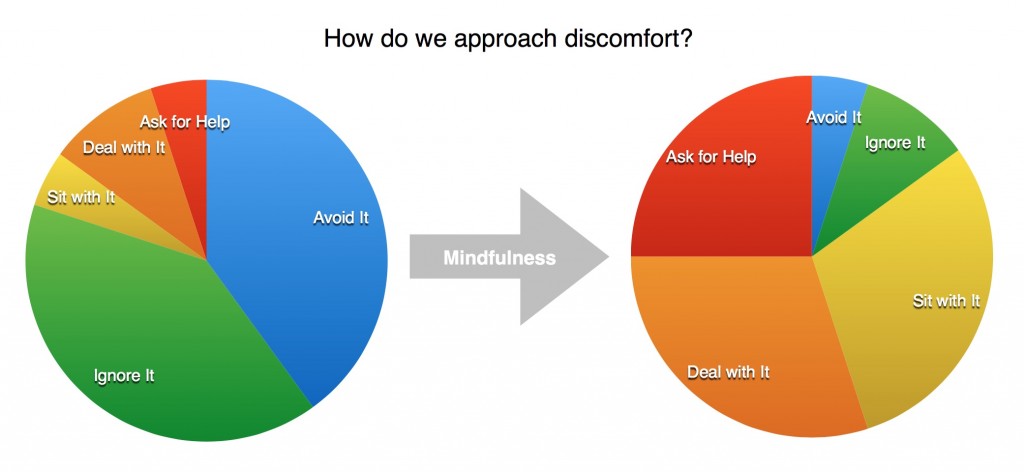Strategies for Dealing with Discomfort
I’ve written before about sitting with discomfort. It’s a big piece of the puzzle that is “mindfulness,” and something I think about a lot. As Americans (not to exclude everyone else, I’m sure this happens everywhere), we tend to view discomfort as this untamable beast that will destroy our picture-perfect lives if we let it show its teeth.
But discomfort is a fact of life. It’s going to part of our experience no matter how hard we try to protect ourselves and our loved ones from it. And it goes further: discomfort is where the most of our personal growth happens. It’s not even a bad thing. If we are to expand our boundaries and comfort zones, we have to accept that discomfort is a part of life and even embrace it at times.
There are five main strategies we have for dealing with discomfort. We can either try to avoid it in the first place, ignore it and push through, sit with it and observe, deal with it ourselves, or ask for help. My experience with mindfulness is that it has shifted how I respond to discomfort from avoiding and ignoring to observing and healing.
I made this awesome pie chart to how regular contemplative practice can change our experience with dealing with discomfort. This data is 100% made up, but the colors are great and having a chart on a blog makes it look so real. SO REAL! Check it.
Let’s take a quick look at each one.
Avoid it. Classic move. Here we don’t even get far enough to admit that the discomfort could be a possibility. We go to great lengths to avoid it, in all likelihood creating more discomfort (or else building up internal shame and repression) along the way. This is generally bad news. There are certainly some discomforts that we should avoid (Life Pro Tip: Get a good mattress. Long-term back pain is not worth the cheaper alternative.), but for small, natural discomforts, it’s better to just face them and get some good practice dealing with it. Sore from going to the gym? Learn to love it!
Ignore it. Again, this is a favorite of the success-driven world. Power through! Haven’t gotten enough sleep for a few nights (or weeks)? Drink more coffee! Energy drinks (eww)! This is a big one in relationships. We ignore the difficult conversations we need to be having, and instead opt for business-as-usual. Ignoring discomfort tends to allow it to build up until it reaches some kind of breaking point, which won’t be pretty. Sometimes we need to do this for short stretches to meet deadlines, create meaningful work, and provide for our families, but we should always be aware of what’s happening and keep in mind that it should be temporary.
Sit with it. This is the main point of the post I linked to earlier on. By sitting with discomfort and just observing it, we learn to be comfortable in more challenging situations. This allows us to grow and develop a deep sense of happiness.
Deal with it. Some discomforts aren’t good to sit with for a long time, particularly if they are related to an injury (physical or emotional) in the body. Often when I’ve been neglecting my yoga practice, my body feels discomfort in the form of tightness and aches. I’ve learned that this is a sign that I need to get back into it and deal with those discomforts. Right now I’m icing my hamstring for a minor strain. I know I’ll feel better about everything if I clean my house. Take action!
Ask for help. Oh boy, this is a hard one. Sometimes we need a good friend, and sometimes we need a professional. We can’t do everything for ourselves all the time, and we’ll run ourselves into the ground if we try. Western medicine has taken an approach of only focusing on the extreme cases where something is obviously damaged. Most of the time we’re not in this situation, but we may still need healing or help. Seeing a therapist is always a good idea, regardless of how positive we’re feeling. Acupuncture, massage, chiropractic, meditation, reiki, and whatever else you’re into, can all help us go beyond our baseline feeling of “not injured” to feeling great (they can also deal with some of those injuries!).
Once we recognize these different approaches to discomfort, our contemplative practice will begin to provide us the wisdom to know which is the most appropriate route, or combination of routes, to take at any given time.





Leave a Reply
Want to join the discussion?Feel free to contribute!